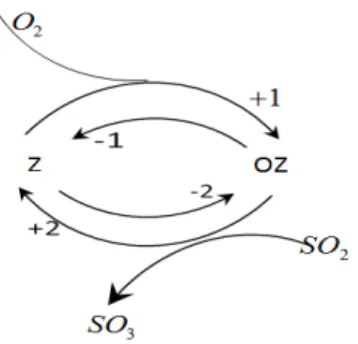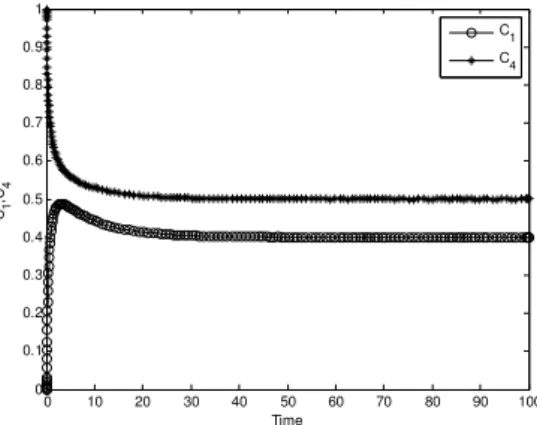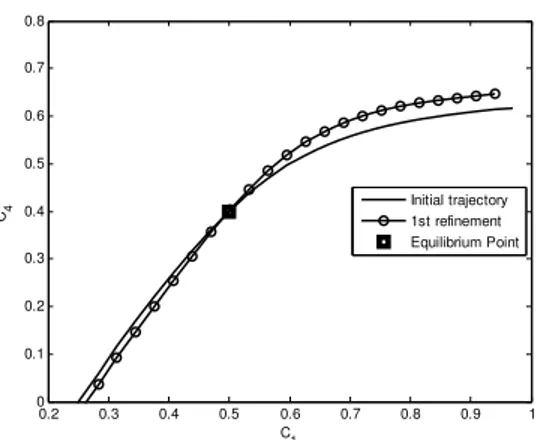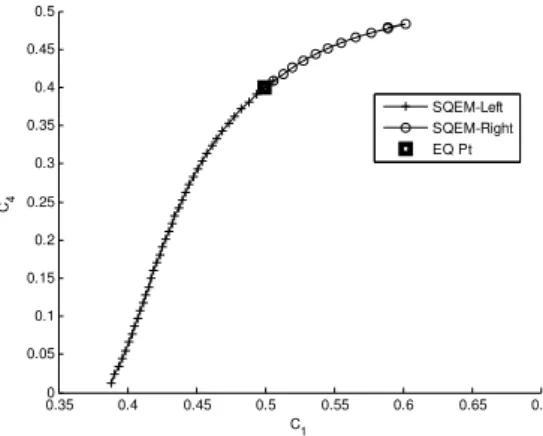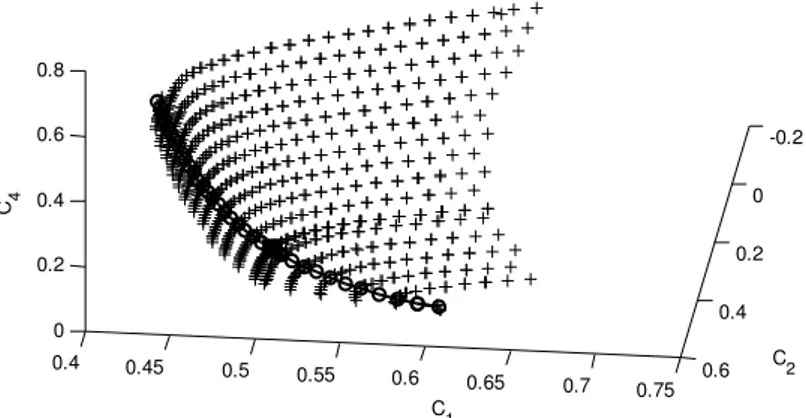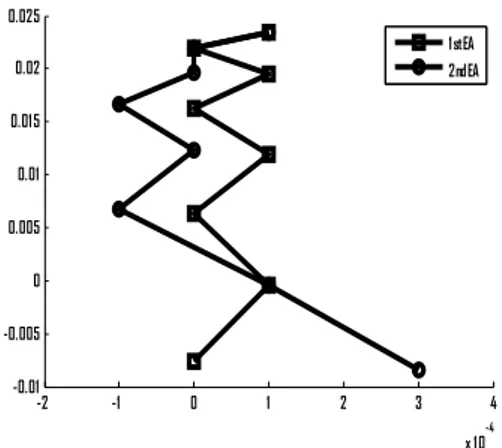Article
Measuring the complex behavior of the SO
2oxidation reaction
Muhammad Shahzad1, Sumaira Rehman1, Rabia Bibi1, Hafiz Abdul Wahab1, Saleem Abdullah1,
Sarfraz Ahmed2 1
Department of Mathematics, HazaraUniversity, Mansehra, 21300, Pakistan 2
Department of Mathematics, Abbottabad University of Science and Technology, Abbottabad, Pakistan E-mail: shahzadmaths@hu.edu.pk
Received 27 April 2015; Accepted 5 June 2015; Published 1 September 2015
Abstract
The two step reversible chemical reaction involving five chemical species is investigated. The quasi equilibrium manifold (QEM) and spectral quasi equilibrium manifold (SQEM) are used for initial approximation to simplify the mechanisms, which we want to utilize in order to investigate the behavior of the desired species. They show a meaningful picture, but for maximum clarity, the investigation method of invariant grid (MIG) is employed. These methods simplify the complex chemical kinetics and deduce low dimensional manifold (LDM) from the high dimensional mechanism. The coverage of the species near equilibrium point is investigated and then we shall discuss moving along the equilibrium of ODEs. The steady state behavior is observed and the Lyapunov function is utilized to study the stability of ODEs. Graphical results are used to describe the physical aspects of measurements.
Keywords chemical kinetics; key variables; slow manifold; refinement; Lyapunov function.
1 Introduction
Chemical materials play an effective role, not only in our daily life, such as plastics and different types of drinks, but they are also used for manufacturing defense equipments. The chemical industry is a necessary part of our development as it deals with diverse chemical reactions such as catalytic reactions, which have numerous applications in chemical industries including newly emerging applications in fine chemicals and pharmaceuticals (Roy and Chaudhari, 2005). So, the analysis of such chemical reactions has great importance. These chemical reactions vary from simple to complex depending on their corresponding nature. Gas-solid catalytic reactions are complex reactions taking place in industrial chemical processes. So it needs their theoretical and experimental investigations. Different approaches and methods have been developed for analyzing different aspects of linear chemical reactions by several researchers (Gorban and Karlin, 2003; Hangos, 2010; Roy and Chaudhari, 2005). On the other hand, due to the complexity of nonlinear chemical reactions, less attention is given to their studies. In this paper, an attempt is made to reduce the complexity and explore hidden aspects of some nonlinear chemical reactions (either fast or slow).
Computational Ecology and Software ISSN 2220721X
URL: http://www.iaees.org/publications/journals/ces/onlineversion.asp RSS: http://www.iaees.org/publications/journals/ces/rss.xml
Email: ces@iaees.org EditorinChief: WenJun Zhang
Computational Ecology and Software, 2015, 5(3): 254-270
IAEES www.iaees.org 2 Paper Organization
Most chemical reactions have two steps in terms of the rate of occurrence i.e. fast processes and slow processes. The fast processes relax much faster than slower ones. During the relaxation, trajectories in the phase space move towards lower dimensions and converge towards the equilibrium point and after that, they start moving along it (Chiavazzo et al., 2007). This concept is represented with the help of LDM in section 2 where the system is reduced into two species in sub-section 2.2. While the steady state behavior (Bothe and Pierre, 2010; Segel and Slemrod, 1989) of the species also approaches towards the equilibrium point after completing the transition period (Fig. 3), the flow of a vector field near the equilibrium is combined with the initial approximate solution of QEM (Fig. 5).
The general idea of grid construction is given in section 3 to measure a one/higher dimension manifold. While for stability measure we use Lyapunov function is described in section 3.1.
As the solution given by QEM (Fig. 2) is far away from the exact solution shown in section 4, it is refined with the MIG (Fig. 4a, 4b). The other way left is to apply a more accurate method, for which, we apply the SQEM method (Fig. 6a) because it gives a better approximation than QEM. This is then proved by applying MIG over it and no change in the approximated 1D solution is observed (Fig. 6b). Therefore, we proceed towards the two dimensional manifold by applying the concept of SQEM and measure the 2D surface (Fig. 7). The variation in eigen values during the whole process, which is given by fast and slow processes, is calculated (Fig. 8). Finally, we conclude results in section 5.
3 Background
Different chemical reactions have different structural natures as well as distinct kinetic behaviors depending on the type of species. As a consequence of the diverse nature of chemical kinetic structures, corresponding equations can be associated with several time scales. Many physical aspects of chemical reactions are described by Slow Manifold (SM) in a better way. Thus SM plays a key role in the analysis of kinetics in chemical reactions of associated species. There are various approaches, (Chiavazzo and Karlin, 2008; Maas and Pope, 1992b; Muhammad Shahzad, 2015; Succi, 2006) which eliminate fast variables and reduce corresponding equations of the considered system into Slow Manifold (SM). Few of them are recently introduced and they are discussed in this paper in detail.
Slow Invariant Manifold (SIM) provides a simple way to study the dissipative systems of chemical kinetics and the computation of SIM after reducing the system in lower dimensions does not affect the accuracy of results.
4 Experiments
Fig a. General example of two steps, reversible reaction involving five chemical species. In the first step, 2
O react with Z (catalyst) and transformed into Z-oxide. Second step, OZ oxidizes sulphur dioxide into sulphur tri-oxide and re obtain Z. While +, - are the forward and backward reactions and 1, 2 indicates first and second step reactions.
1 1
2 2
1 2
0.5
2 3
2 k 2
k k
k
O Z OZ
OZ SO SO Z
(a)
2 1
,
2,
3,
2 4,
3 5O
c Z
c OZ
c SO
c
SO
c
1
0.5,
20.1,
30.1,
40.4,
50.1
eq eq eq eq eq
c
c
c
c
c
In this two-step heterogeneous nonlinear
SO
2 oxidation reaction, five chemical components2 2 3
(
O Z OZ SO SO
, ,
,
,
)
are involved, which are formed by three chemical elements (O, Z and S). All these chemical species participating in the mechanism can be divided into two groups (i.e.1: reactants and productsand 2: intermediates). Intermediates are not involved in the overall reaction as they are generated in one step
and consumed in another step and hence they are just a part of the cycle (Gorban and Shahzad, 2011). Now, let
us explain these two steps with some details.
In the first step, oxidizing agent
O
2 react together with catalyst Z and here Z is oxidized gaining oxygenatom and transformed into Z-oxide and in the second step, oxidizing agent is
OZ
which oxidizes sulphurdioxide into sulphur tri-oxide and we reobtain catalyst Z. Catalyst Z is only used to proceed the reaction,
which takes part in the reaction, but at the end, we recovered it. Here surface intermediates are Z and OZ while
the overall reaction step involved species
O
2,
SO
2 andSO
3.We apply Horiuti method for finding the rate equation for reversible reaction at known rates of forward
reaction as well as for obtaining equilibrium coefficient of the overall reaction (Marin and Yablonsky, 2011). It
uses Horiuti numbers by means of multiplying the reaction equation in step one and step two with the Horiuti
numbers 1 and 2 respectively, and afterwards, adding the equations. Every participating intermediate will be
either vanished or cancelled out, i.e.
2 2 3
1.
O
1(2 ) 2.
Z
OZ
2.
SO
1(2
OZ
)
2.
SO
2.
Z
O
2
2
Z
2
OZ
2
SO
2
2
OZ
2
SO
3
2
Z
2
SO
2
O
2
2
SO
3(i.e., Intermediates are cancelled from both sides)
4.1 Linear algebra and law of mass conservation
The following relationship is valid in a regular chemical mixture:
T
c e
A
(1)Computational Ecology and Software, 2015, 5(3): 254-270
IAEES www.iaees.org
2
2 2 3
2 2 3
3
(3 5) (3 1)
(5 1)
2
2
3
2
0
1
2
3
.
0
1
1
0
0
.
0
0
0
1
1
O
O OZ SO SO
Z
T
OZ
c Z OZ e
SO SO SO
SO
A
Consequently;2 2 3
2 3
,
,
,
2
2
3
t O O OZ SO SO
t Z Z OZ
t S SO SO
(2)where
t O,,
t Z, and
t S, are total number of moles of O, Z and S atoms respectively. A catalytic surfacereaction proceeds by means of surface intermediates, which includes active site. In this mechanism, Z and OZ
are surface intermediates involving active site Z. The total amount of concentration of surface intermediates is
preserved and it can be expressed as:
,
Z OZ t Z
(3),
AZ t Z
z
(4)As in this case there is only one active site (i.e
N
as
1
Z
), which is part of each of intermediates (Z, OZ).In generalized form, it can be written as:
int
, 1
N
ik i t k
i
b
andint , 1 N t k ik i
b
j
(5)where
b
ik is the number of active sites of typek
which are parts of surface intermediates, i.e.
i andi
are the amounts (Mol) and concentrations (molm
cat2 ) respectively, of the ith surface intermediates.While
t k, and
t k, are the total amount (Mol) and total concentration (Mol) respectively, for active sitesof type
k
.Now let us check the relation between the stoichiometric matrix S and a molecular matrix A.
(2 5)
(5 3)
2
0
0
0
1
0
1
2
2
0
0
. 1 1 0
0
1
1
1 1
2
0
1
3
0
1
(2 3) (2 3)
2 0 2 0 0 0 2 2 0 0 0 0 0 0 0
0 0 0
0 0 1 2 3
0 1 1 0 0
0 0 0 1 1
0 0 0
(6)4.2 Key components
Such components, for which we need to know the concentration, by which we are able to determine the
amounts of all other components, are called Key Components and they are denoted by
N
kc. We can find thenumber of key components by using the following equation:
( )
kc c
N
N
rank A
(7)c
N
are the total number of components involved in the mechanism. A is a molecular matrix while its rowsrepresent the component participates in the reaction and the columns represent the chemical elements which
form components (i.e.
A N
(
c
N
e)
). Rank (A) is the rank of molecular matrix, which represent themaximum number of linearly independent variables in a row or column. It is important to note that
( )
min(
c,
e)
rank A
N N
.4.3 Matrices and independent routes of complex reactions
The existence of intermediates in complex reaction can be affected by the stoichoimetric matrix for the
intermediates (
S
int ) where the size ofS
int matrix is (N
s
N
int ). Where,s
N
= number of steps in detailed mechanismint
N
= number of intermediates.int
S
= stoichoimetric matrix of intermediatesAs intermediates are not present in the overall reaction so we have to multiply the stoichiometric matrix of
intermediates and the Horiuti matrix by linear algebraic method i.e.
S
int(
N
s
N
int)
(
N
s
N
rr)
whererr
N
= number of the linearly independent reaction routes. And when we multiply
T andS
int matrices,we get matrix
TS
int(
N
rr
N
int)
that is equal to zero, i.e.
TS
int
0
.int int
(
)
asrank S
N
N
(8)as
N
= number of active sites in mechanism.Computational Ecology and Software, 2015, 5(3): 254-270
IAEES www.iaees.org int
(
)
s rrrank S
N
N
(9)Combining relation (a) and (b) we get:
int
rr s as
N
N
N
N
(10)This is the Horiuti rule. Let us consider an example (a), we have
N
s
2
,N
int
2
. As size ofint s int
S
N
N
Intermediate matrix would be(2 2)
.Z OZ
int
2
2
1
1
1
2
Step
S
Step
Similarly, the size of the Horiute matrix (
) =(
N
s
N
rr)
implies,
2
1
s
N
Nrr
(NsNrr)
(2 1) , i.e. (2 1)1
2
.As we multiply
TS
int we take transpose on both sides(2 1)
1
2
T T
,
1 2
(1 2)T
, int
(1 2) (1 2)
(2 2)
2
2
.
1 2
.
0 0
1
1
T
S
int ( )
( rr s)
.
int( s )int
intT
N N
N N N N rr
T
S
S
.4.4 Rate equation by Horiuti and Borekov
If we take
SO
2 oxidation reaction, there is a two-step mechanism and all the involved components can becategorized into two groups: reactants and products. Both of them are controllable species, which means that
their concentration can be set during an experiment, while it is evident that intermediates are uncontrollable
species. Boreskov analyzed the oxidation of
SO
2. According to both Boreskov and Horiuti, second step is therate limiting step, which is potentially much faster than the first step, where
lim
2
is the Horiuti numberfor the rate limiting step. Boreskov used the empirical power law to define the ratio of forward and reverse
rates as:
Rate equation = difference between the forward and reverse reaction rates, i.e.
1
( ) /
r( ) /
pr
r
k f
c
w
k f
c
w
r
1
( )
( ) /
(
)
(
)
r
r p eq
p
f
c
k f
c
k
f
c
k
f
c
,k
k
eqk
.Hence,
1
1
( )
(
)
m
r eq
p
f
c
r
k
r
f
c
Herem
is boreskov molecularity: a number relating to the rate limiting step.Therefore, for considering nonlinear mechanism, rate equation can be written as:
1
1
( )
1
(
)
m
r eq
p
f
c
r
r
k
f
c
.
5 Formalism of Invariant Manifold
The solution of the variation problem
G
min
(i.e., Lyapunov function), under consideration of theconstraints (2) along with the reduced decrypted form represents QEM (Chiavazzo et al., 2007). The initial approximations given by QEM or SQEM are not exact and need refinement. For this, the best available method is a ‘method of invariant grids’ (MIG). This is basically an iterative procedure used for the construction of slow invariant manifold (SIM). Therefore, we apply this method over the initial approximation given by QEM and SQEM and observe changes.
5.1 Grid construction
The method of invariant grid (Gorban et al., 2004) has recently been suggested by Gorban and Karlin while it was applied by many authors. The principle idea behind this construction is ‘construct such an approximated grid, which lies on the invariant manifold (when refined)’ with the mapping of finite dimensional grids into a dynamical phase space. Furthermore, the construction strategies have been defined in (Chiavazzo and Karlin, 2008).
By having the known node (equilibrium) the next node is calculated by the addition of shift vector;
hc
0pi.e.,
c
0p1
c
0phc
0p, which also satisfies the same condition (the condition of atomic balance). For this, thebest way is to express this shift vector in the form of linear combination of vectors
v
i, i.e.0
1
z
p i i
i
hc
v s
(11)Here,
s
i are the null basis given by atomic balances having dimensionz
n l
. Thus the spaceperpendicular to this is given by the tangent space
T
that lies over the surface at each QEM node andprovides the linear constraints for the system. The reason behind this partition is simple that we are looking
for those points, which minimize the Lyapunov auxiliary function
G
.In this way, while starting from equilibrium point
c
0p we proceed towards the next pointc
1puntil weIAEES
lowest v
lower an
we shall
Fig.1a Th in both dir
Fig.1b Ex vector (gri The g 2004), i.e 1 1
,
(
,
z j i z sl i pt s
v s
c
h
‖
‖
pc
h
‖
‖
ivalue for one
d upper boun
consider each
e general idea rections.
tending the one id points) over
general idea o
e
2
(
)
0,
.
i i j
i i
s
t
s
ò
s Euclidean Com -dimensional nd. Similarly,h grid point o
of grid constru
e dimension cur each grid point
of grid constr
,
(
)),
j
G c
pnorm of shif
mputational Ecol
l curve. In si
for a two-dim
of the 1-D cur
ction starting fr
rve to two dime of one dimensi
ruction is sho
1,...,
j
ft vector,
t
jlogy and Softw
imple words,
mensional sit
rve instead of
from the equilib
ensional curve w ional curve.
wn in Fig. 1 w
1
z
is a vector
ware, 2015, 5(3)
, a researcher
tuation, our ap
f a single poin
brium point to t
within second s
while the sys
r of
T
and: 254-270
r can say tha
pproach will
nt.
the next point b
slowest eigen sp
stem will take
spaning line
ww
at we are loo
be the same,
by adding a shi
paces when add
e a form (Gor
e
l
lies betwww.iaees.org
oking for, its
but this time
ft vector
hc
opding a new shift
rban et al.
(12)
ween the two s
e,
t
o
points
( , )
t A
j
0, ( ,
t v
j sl)
0
.
i are unknown variables and
is Gradiant. The solution of the abovesystem at each grid point delivers two real solutions
c
Ip,
c
IIp as shown in Fig. 1 above while extending theidea for 2D, we need another directional vector
v
sl.As the first slow trajectory is obtained by the selection of slowest left eigenvector
v
1sl at each point in thesystem (12), similarly with the help of second slow vector
v
2sl, we get another trajectory measured at each gridpoint of 1D curve shown in Fig. 1.
In a dynamic system and while dealing with the system of differential equations, various types of stability
may be described. Our concern for stability is closer to an equilibrium point. This may be discussed by the
theory of Lyapunov. In simple words, we can say that the system starts out near an equilibrium point
c
0p andit stays near to it forever, then it can called as Lyapunov stable. Moreover, it is asymptotically stable if all
solutions that start out near
c
0p converge towardsc
0p.6 Result and Discussion
In the above mechanism (a) the involved chemical components are five (i.e.
N
c
5
) formed by the threeelements (i.e.
N
e
3
). Thus, for the system the key component (7) we haveN
kc
N
c
N
e
2
. Also,( )
min(
c,
e)
rank A
N N
rank A
( )
min(5, 3)
2
3
.While,
N
int =2 (i.e. Z, OZ),N
as = 1 (i.e. Z) andN
s = 2 (i.e. two steps, reversible reaction) give theequation (8) as
rank S
(
int)
N
int
N
as
2 1 1
. And number of reaction routes can be found by therelation (9) as
N
rr
N
s
N
int
N
as ,N
rr
2 2 1
,N
rr
1
. Also, we can verify the rank of anintermediate stoichiometric matrix by relation (10)
rank S
(
int)
N
s
N
rr
2 1 1
(Verified).Now, we are able to reduce the system to two dimensions and for this purpose, the possible outcome can be
found by the relation
!
!(
)!
n r
n
X
r n r
.As a first step we have applied the quasi equilibrium manifold method over the example (a) after reducing
the species. Then, according to variation problem (Chiavazzo et al. 2007; Gorban and Karlin 2005) we have:
G
min
( , )
v c
x
Ac
e.Computational Ecology and Software, 2015, 5(3): 254-270
IAEES www.iaees.org
While under constant volume and pressure or for a (fixed) closed system, the reaction mechanism is supported
by the Lyapunov function
G
and thus, the system will acquire the following form:1
c
x
,c
2
2
x
y
.5
,c
3
2
x
y
0.7
,c
4
y
,c
5
y
0.5
, i.e.5
1
ln
eq1
i i
i i
c
G
c
c
,2
2
( , )
( , )
0,
0
G x y
G x y
y
y
. (14)y
is the relation betweenc
1 andc
4 whilev
(1,0,0,0,0)
.Solving the system (14), the initial approximations are shown in Fig. 2.
Fig. 2 The initial approximation measured by QEM in its reduced form
c c
1,
4 of chemical species. A black circle shows an equilibrium point (0.5, 0.4).Fig. 3 After completing the transition period, the solution trajectories (
c c
1,
4) goes to steady state after starting from (0,1).The reduced mechanism with respect to
c c
1,
4 also approaches towards its equilibrium point aftercompleting its transition period as shown in Fig. 3. Similarly, other possible outcomes can be obtained and they can be shown in the same manner.
0.2 0.3 0.4 0.5 0.6 0.7 0.8 0.9 1 0
0.1 0.2 0.3 0.4 0.5 0.6 0.7 0.8
C
1
C4
Initial trajectory Equilibrium Point
0 10 20 30 40 50 60 70 80 90 100
0 0.1 0.2 0.3 0.4 0.5 0.6 0.7 0.8 0.9 1
Time
C1 ,C4
C1 C4
Fig. 4a Refinement of the Initial approximation (measured by QEM) using the method of the Invariant Grid at each point.
Fig. 4b The second refinement (measured by MIG) lays over the first refined trajectory. This means only first refinement gives the exact solution.
Now, refining the initial QEM in Fig. 4 the behaviour of the initial trajectories near an equilibrium point can be seen in Fig. 5.
Fig. 5a Phase flow near the equilibrium point; i.e. lines along with the arrows (vector field) indicate the direction of solution trajectories converging towards the equilibrium point (black circle).
0.2 0.3 0.4 0.5 0.6 0.7 0.8 0.9 1 0
0.1 0.2 0.3 0.4 0.5 0.6 0.7 0.8
C
1
C4
Initial trajectory 1st refinement Equilibrium Point
0.2 0.3 0.4 0.5 0.6 0.7 0.8 0.9 1 0
0.1 0.2 0.3 0.4 0.5 0.6 0.7 0.8
C1
C4
Initial trajectory 1st refinement 2nd refinement Equilibrium Point
0 0.2 0.4 0.6 0.8 1
0 0.2 0.4 0.6 0.8 1 1.2
Computational Ecology and Software, 2015, 5(3): 254-270
IAEES www.iaees.org
Fig. 5b The phase flow near the equilibrium point along with qem approximation passing through it, i.e (0.5, 0.4).
Now let us discuss another approximation method (SQEM), which not only reduced the system dimension,
but also gave a better approximation as compared to QEM. Thus, according to system (13) and (14) we will
obtain an explicit form
1
0.6043696330 .3721407402
.7599361654
c
y
x
,2
0.7087392659 1.744281480
1.519872331
c
y
x
,3
0.5087392659 1.744281480
1.519872331
x
c
y
,c
4
y
,c
5
y
0.5
,after the selection of vector
v
(slowest left eigenvector) while Jacobin matrix J is measured at an equilibriumpoint
.01
.10
.10
0
0
.02
.40
.40
.05
.2
.02
.40
.40
.05
.2
0
.2
.20
.05
.2
0
.2
.20
.05
.2
J
(15)
delivere the first and second slowest eigenvectors, i.e.,
1
[ -0.1171 -0.2997 0.2997 -0.2178 0.8713]
sl
v
2
[0.0278 0.6522 -0.6522 -0.0935 0.3739]
sl
v
(16)0.2 0.3 0.4 0.5 0.6 0.7 0.8
0 0.1 0.2 0.3 0.4 0.5 0.6 0.7 0.8
C1
C4
Fig. 6a Initial approximation measured by SQEM started from the equilibrium point (black circle) to both directions, using Euclidean norm 2 2
1 0
ò .
Fig. 6b Refining the initial trajectory (measured by SQEM) with the method of invariant grids shows no difference, i.e. lies over the same approximated curve.
This is now obvious from the above results (refinement Fig. 6b) that SQEM is much better than QEM
approximation. Therefore, one dimensional (SQEM) curve (Fig. 6) can be extended to two dimensions by
applying the method discussed in (3.1). For this purpose, we first take all the measurements (12) with respect
to second slowest vector
v
sl2 and obtain 1D curve. Then, starting from each grid point of 1D curve, we repeatthe process with vector
v
1sl. In this way, we obtain a surface, which lies in a phase space as shown in Fig. 7.0.350 0.4 0.45 0.5 0.55 0.6 0.65 0.7 0.05
0.1 0.15 0.2 0.25 0.3 0.35 0.4 0.45 0.5
C1
C4
SQEM-Left SQEM-Right EQ Pt
0.350 0.4 0.45 0.5 0.55 0.6 0.65 0.7 0.05
0.1 0.15 0.2 0.25 0.3 0.35 0.4 0.45 0.5
C1
C4
Computational Ecology and Software, 2015, 5(3): 254-270
IAEES www.iaees.org
Fig. 7 Initially approximated 1D SQEM (circle line) is further extended (at some of its grid point) for 2D SQEM (black plus) in the second slowest eigen space. The equilibrium is indicated in square and the Euclidean norm in this case is .
Fig. 8a Above figure indicates the variation in eigenvalues (absolute) measured at each grid point (before and after the equilibrium point) with respect to time in case of SQEM.
Fig. 8b Above figure indicates the variation in eigenvalues (absolute) measured at each grid point during the whole process with respect to time measured with respect to SQEM.
0.4 0.45 0.5 0.55 0.6 0.65 0.7 0.75
-0.2
0
0.2
0.4
0.6 0
0.2 0.4 0.6 0.8
C2
C1 C4
2 2
0 .5 1 0
0 0.1 0.2 0.3 0.4 0.5 0.6 0.7 0.8 0.9 1 0.1
0.2 0.3 0.4 0.5 0.6 0.7 0.8 0.9 1
Time
E
ige
n
v
al
ue
v
a
ri
a
ti
on
Fast Eigenvalues Slow Eigenvalues
0 0.1 0.2 0.3 0.4 0.5 0.6 0.7 0.8 0.9 1 0.1
0.2 0.3 0.4 0.5 0.6 0.7 0.8 0.9 1
Time
E
ige
nv
a
lue
v
a
ri
a
ti
on
Fast Eigenvalues Slow Eigenvalues
Fig. 9a. Error analysis of the Initial QEM with the MIG are shown for some grid points.
Fig. 9b. In case of SQEM the initial and the refined curve shows no difference.
Table 1 The above tables shows the difference (positive) between the initial (I) and refined (R) values of the eight grid point, which are presented in Fig.9.
Fig.
9a.
|I-R1| |I-R2|
1 0.0234 0.0234
2 0.0219 0.0219
3 0.0195 0.0197
4 0.0163 0.0166
5 0.0119 0.0123
6 0.0063 0.0067
7 0.0004 0.0005
8 0.0076 0.0085
Fig. 9b. 1 2 3 4 5 6 7 8
|I-R1| 0.3606
x 10-03
0.2828
x 10-03
0.2828
x 10-03
0.2236
x 10-03
0.1414
x 10-03
0.1414
x 10-03
0.1000
x 10-03
0
-2 -1 0 1 2 3 4
x 1 0
-4
-0.01 -0.005 0 0.005 0.01 0.01 5 0.02 0.025
1 st EA 2nd EA
-3 -2 -1 0
x 1 0
-4
0 1 2
x 1 0
-4
Computational Ecology and Software, 2015, 5(3): 254-270
IAEES www.iaees.org 7 Conclusion
In this paper, the model reduction is done by employing a slow manifold approach, for which, different
techniques of QEM including steady state approximation and SQEM are used. Although the Intrinsic Low
Dimensional Manifold (ILDM) method, which has been presented by Maas and Pope, 1992 (Maas and Pope,
1994; Maas and Pope, 1992a; Schmidt and Maas, 1996), is one of the efficient methods used to compute SIM.
But the refinement (with MIG) of the QEM, SQEM gives the same results.
The present paper gives an idea that after measuring an equilibrium point, a researcher can move to the
point in a phase space near it and then towards one dimensional curve. After that, two dimensional curves can
be measured while the one dimensional curve lies as a part of it.
By utilizing these approaches, five different species are reduced into some sets of two/three species, which
are included in a model of a particular chemical reaction. The convergence of species also depends on their
transient nature. During the implementation, it is observed that all species have a property that they converge
towards their equilibrium points and then move along it. The equilibrium of ODE’s are stable, which is then
represented by the steady state. The stability of ODE’s can be measured by Lyapunov scalar function
G
while the variation in eigenvalues indicates our selection of slowest variation at each point. This approach can
be utilized for analyzing different chemical reactions associated with species with diverse physical nature.
References
Bothe D, Pierre M. 2010. Quasi-steady-state approximation for a reaction–diffusion system with fast
intermediate. Journal of Mathematical Analysis and Applications, 368(1): 120-132
Chiavazzo E, Gorban AN, Karlin IV. 2007. Comparison of invariant manifolds for model reduction in chemical kinetics. Commun Comput Phys, 2(5): 964-992
Chiavazzo E, Karlin IV. 2008. Quasi-equilibrium grid algorithm: Geometric construction for model reduction. Journal of Computational Physics, 227(11): 5535-5560
Gorban AN, Karlin IV. 2003. Method of invariant manifold for chemical kinetics. Chemical Engineering Science, 58(21): 4751-4768
Gorban AN, Karlin IV. 2005. Invariant manifolds for physical and chemical kinetics. Lecture Notes in Physics,
660: 1-489
Gorban AN, Karlin IV. 2005. Entropy, Quasiequilibrium, and Projectors Field. Springer, Germany
Gorban AN, Karlin IV, and Zinovyev AY. 2004. Invariant grids for reaction kinetics. Physica A: Statistical Mechanics and its Applications, 333: 106-154
Gorban AN, Shahzad M. 2011. The michaelis-menten-stueckelberg theorem. Entropy, 13(5):966-1019
Hangos KM. 2010. Engineering model reduction and entropy-based Lyapunov functions in chemical reaction kinetics. Entropy, 12(4):772-797
Maas U, Pope S. 1994. Laminar flame calculations using simplified chemical kinetics based on intrinsic low-dimensional manifolds. Symposium (International) on Combustion. 1349-1356, Elsevier
Maas U, Pope SB. 1992a. Implementation of simplified chemical kinetics based on intrinsic low-dimensional
manifolds. Symposium (International) on Combustion: 103-112, Elsevier
Maas U, Pope SB. 1992b. Simplifying chemical kinetics: intrinsic low-dimensional manifolds in composition
space. Combustion and Flame, 88(3): 239-264
Marin G, Yablonsky GS. 2011. Kinetics of Chemical Reactions: John Wiley & Sons, USA
Muhammad Shahzad MS, Muhammad Gulistan, Hina Arif. 2015. Initially Approximated Quasi Equilibrium Manifold. Journal of the Chemical Society of Pakistan, 37: 2
Roy D, and Chaudhari RV. 2005. Analysis of a gas-liquid-liquid-solid catalytic reaction: Kinetics and modeling of a semibatch slurry reactor. Ind Eng Chem Res, 44(25): 9586-9593
Schmidt D, Maas U. 1996. Analysis of the intrinsic low-dimensional manifolds of strained and unstrained
flames. Modelling of Chemical Reaction Systems, Proceedings of an International Workshop, Heidelberg, Germany
